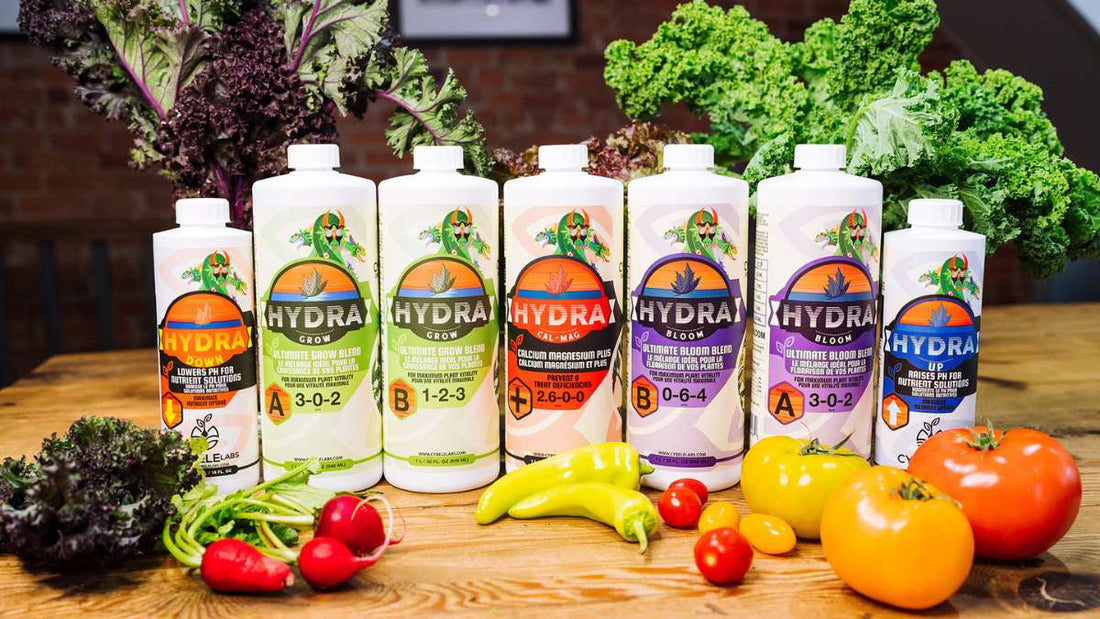Imagine strolling through the garden center, surrounded by colorful fertilizer bags.
Your eyes dart from one product to another, each showing a different number: 10-5-5, 5-10-5, 20-20-20. It's like trying to crack a secret code!
Today, we're diving into N-P-K ratios to demystify those numbers and help you choose the perfect fertilizer for your plants.
Let’s dive in!

The N-P-K Trio: Your Plants' Best Friends
So, what does N-P-K mean when it comes to plant fertilizers, either for soil or hydroponics? Let's break it down:
- N = Nitrogen
- P = Phosphorus
- K = Potassium (for its chemical symbol)
These three nutrients are crucial to your plant's growth and development. Let's dive into their unique features, starting with nitrogen.
Nitrogen (N): Leaf Growth
Nitrogen is a critical player in leaf growth and chlorophyll production, whether you grow in soil or hydroponics. Here's what nitrogen does for your plants:
- Promotes lush, green foliage
- Boosts overall plant growth
- Helps plants produce protein (essential for, well, everything!)
When your plants are nitrogen-hungry, you might notice yellowing leaves, stunted growth, or a general lack of that vibrant green color we all love.
- To prevent this, you can use HydraGreens, a potent kelp-enriched fertilizer with an NPK ratio of 3-1-2 for soil gardening. It provides an optimal nitrogen boost, promoting rapid growth and robust development.
- If you grow hydroponically, the best option is HydraGrow A & B, a two-part liquid fertilizer crafted to enhance hydroponic plant growth.

Phosphorus (P): Helps The Root
While nitrogen helps leaves, phosphorus works hard to promote growth in other parts of the plant.
This nutrient is all about roots, flowers, and fruits. Phosphorus helps:
- Develop strong root systems
- Encourage flower and fruit production
- Boost overall plant strength and disease resistance
A phosphorus deficiency might appear as weak stems, poor flower production, or purple-tinged leaves.
- To address this issue, you can use HydraBloom Flower Basket Edition, a fertilizer with an NPK ratio of 1-4-3 formulated for soil. It optimizes phosphorus, supporting fuller plants and vibrant blooms.
- HydraBloom A & B is the best option for hydroponic plants, with part B containing 6% phosphorus.

Potassium (K): Overall Growth
Last but certainly not least, we have potassium – a multitasker. Potassium is involved in many plant processes, including:
- Regulating water and nutrient movement within the plant
- Improving overall plant health and disease resistance
- Enhancing fruit and vegetable quality
You might see weak stems, brown leaf edges, or poor fruit development if your plants lack potassium.
- Try HydraVeggies, a fertilizer enriched with macro, micro, and kelp nutrients to combat this. Part B's NPK ratio of 1-2-3 delivers an optimal potassium boost, accelerating growth and ensuring plant health when growing in soil.
- Similarly, for growing in hydroponic systems, you can use HydraBloom A and B, with part B containing 4% potassium.

Decoding N-P-K: What Do These Numbers Mean?
Now that you know what each letter stands for, let's crack the numbers! The N-P-K ratio on a fertilizer shows the percentage by weight of each nutrient in the mix.
For example, a 10-5-5 fertilizer contains:
- 10% Nitrogen
- 5% Phosphorus
- 5% Potassium
The remaining 80% is typically made up of other chelated ingredients, nutrients, and fillers.
Choosing the Right N-P-K Ratio for Your Garden
Different plants have different nutrient needs, which can change throughout the growing season.
Here are some general guidelines for choosing the right N-P-K ratio in a fertilizer:
- High nitrogen during the vegetative stage, such as HydraGrow (for hydroponics) or HydraGreens (for soil)
- Higher phosphorus for flowering/fruiting plants, such as HydraBloom.
- Balanced ratios (like 10-10-10) for general-purpose feeding.
Remember, these are just starting points. Always check your plants' specific needs and the fertilizer’s feeding charts to adjust accordingly!

Beyond the Basics: Micronutrients Matter Too!
While N-P-K takes center stage, let's also consider essential micro and macronutrients!
Quality fertilizers include essential minerals like calcium, magnesium, and iron to give your plants a well-rounded diet.
For example, HydraGreens combines macronutrients with over 60 vital micronutrients derived from organic kelp.
This comprehensive approach ensures your plants get complete nourishment for optimal health and growth!

Mastering N-P-K: Your Key to Garden Success
Decoding N-P-K ratios is like unlocking a secret language for gardening success.
By aligning the right nutrient balance with your plant's specific needs, you're setting the stage for a flourishing and vibrant garden.
Whether nurturing delicate flowers, robust vegetables, or lush foliage, the right nutrient mix is your path to greatness.
Ready to nourish your plants to their full potential? Explore our expert guides or choose HydraGarden’s best plant fertilizers in every growth stage!
Why Choose HydraGarden Fertilizers?
- Premium Quality: Crafted with the finest ingredients for unmatched gardening results.
- Developed over 40 years by our master chemist, delivering faster growth and healthier plants.
- Tailored for diverse plant needs, ensuring robust growth and vibrant blooms.
- User-friendly formulas––compatible with hydroponics, soil, soilless, coir, and promix growing methods.
- Canadian Craftsmanship: Support independent family-owned businesses with every purchase.
- Comprehensive Support: Benefit from educational gardening resources and quick, helpful support.

